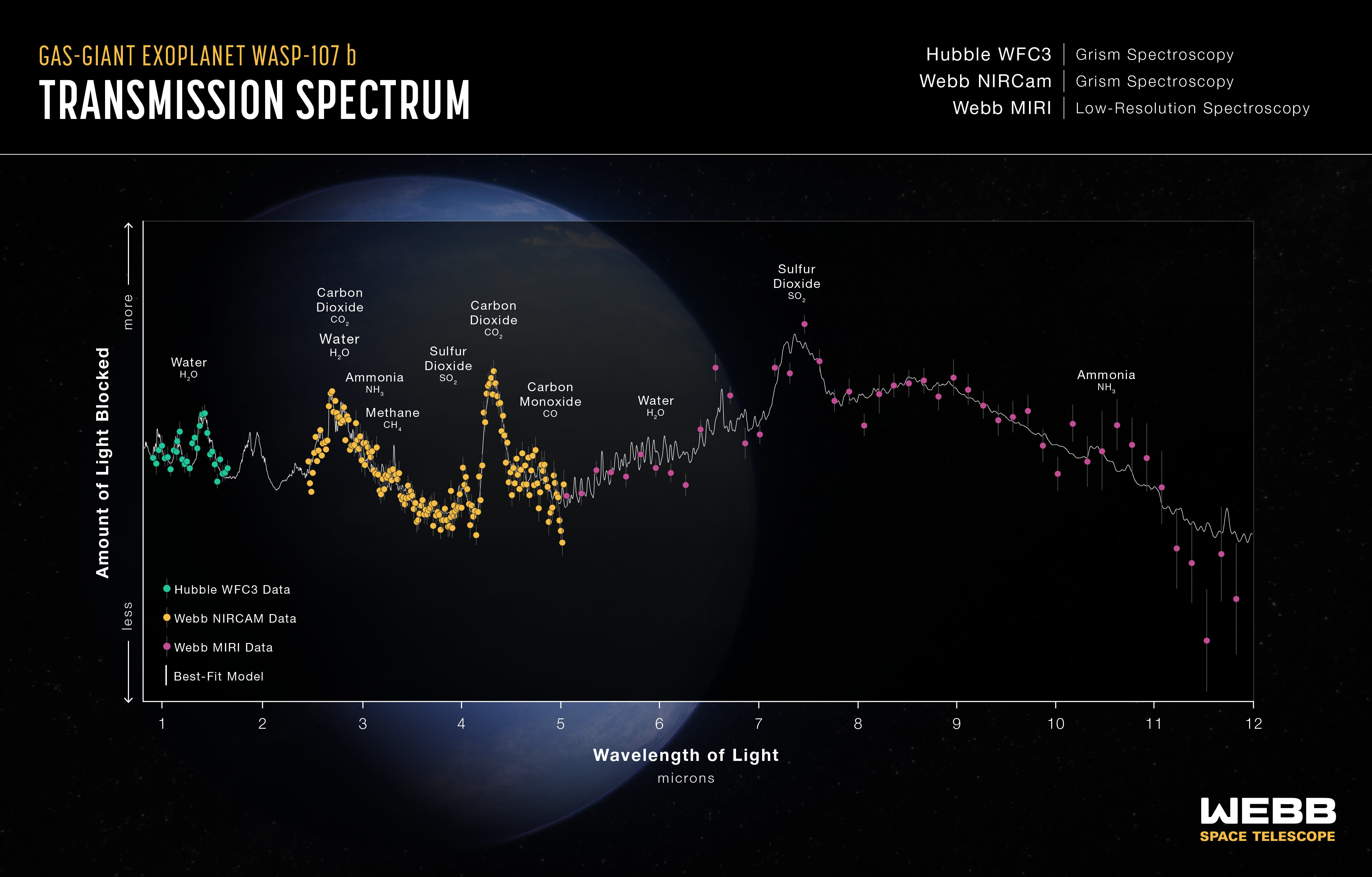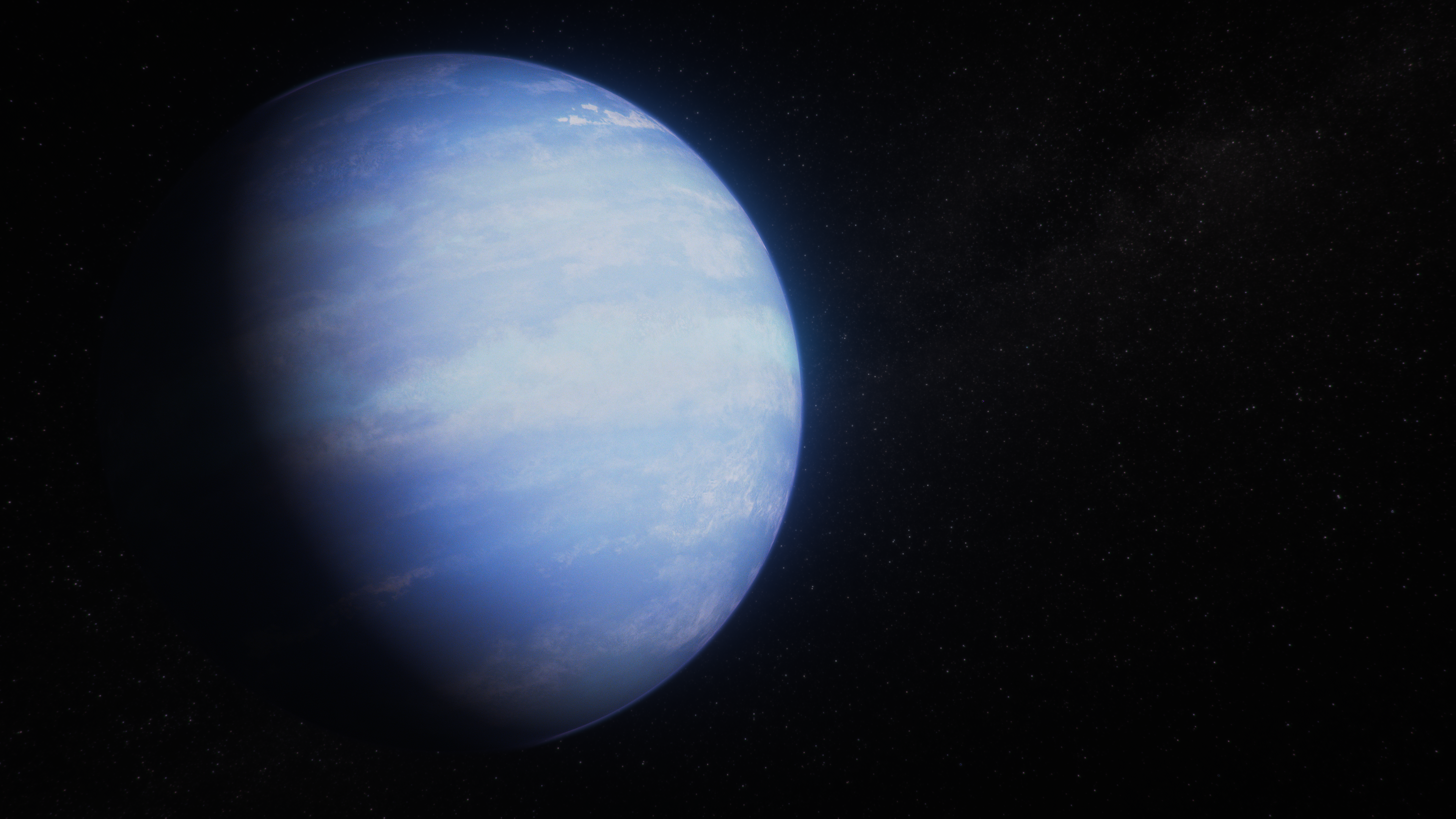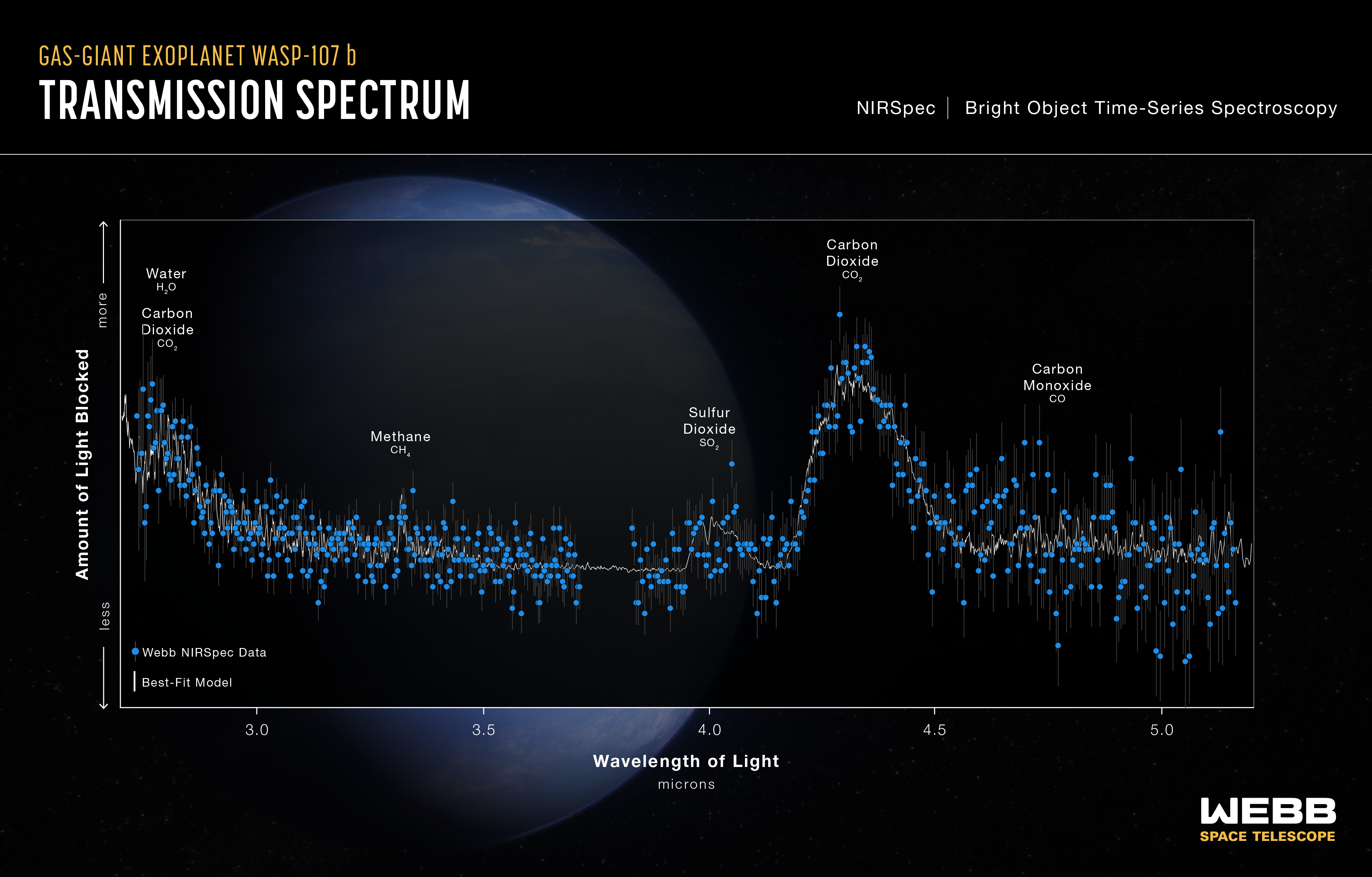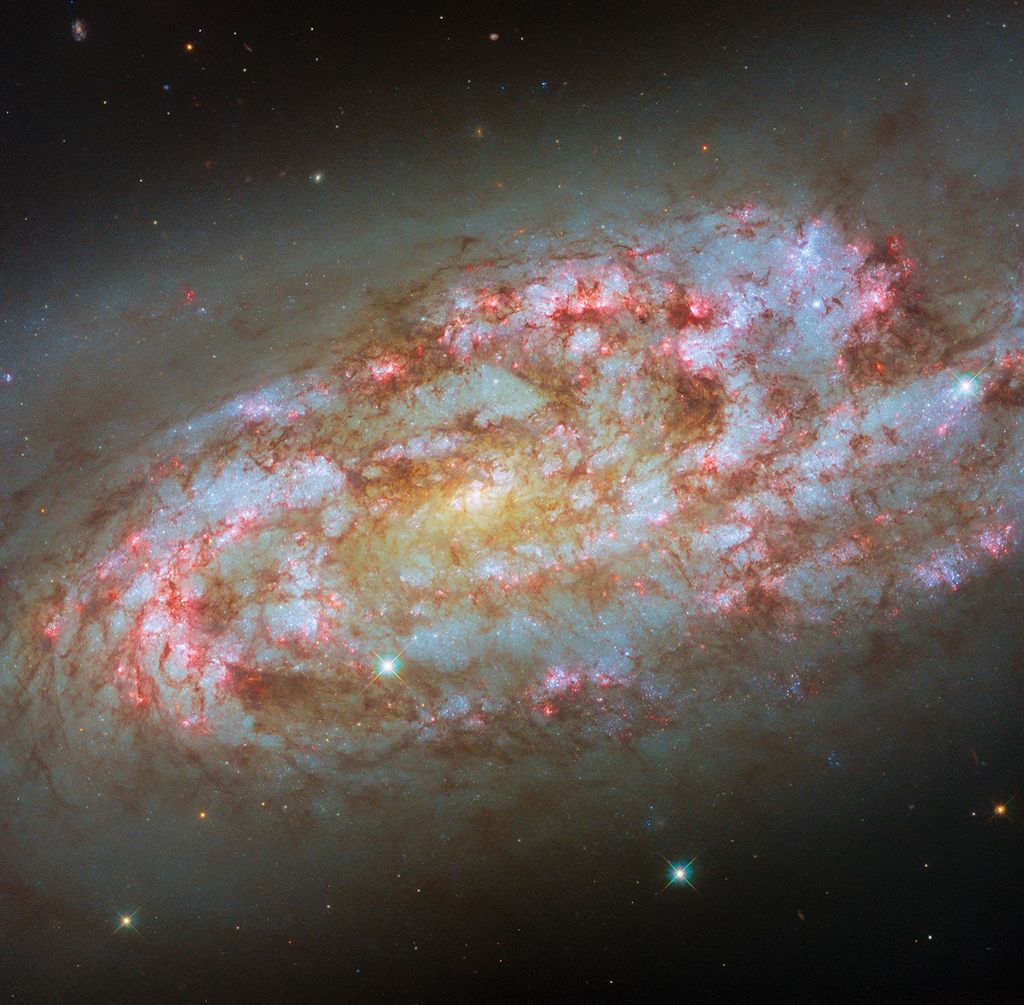1 min read
Warm Gas-Giant Exoplanet WASP-107 b Transmission Spectrum (Hubble WFC3, Webb NIRCam, Webb MIRI)

This transmission spectrum, captured using NASA’s Hubble and James Webb space telescopes, shows the amounts of different wavelengths (colors) of starlight blocked by the atmosphere of the gas-giant exoplanet WASP-107 b.
The spectrum includes light collected over five separate observations using a total of three different instruments: Hubble’s WFC3 (0.8–1.6 microns), Webb’s NIRCam (2.4–4.0 microns and 3.9–5.0 microns), and Webb’s MIRI (5–12 microns). Each set of measurements was made by observing the planet-star system for about 10 hours before, during, and after the transit as the planet moved across the face of the star.
By comparing the brightness of light filtered through the planet’s atmosphere (transmitted light) to unfiltered starlight, it is possible to calculate the amount of each wavelength that is blocked by the atmosphere. Since each molecule absorbs a unique combination of wavelengths, the transmission spectrum can be used to constrain the abundance of various gases.
This spectrum shows clear evidence for water (H2O), carbon dioxide (CO2), carbon monoxide (CO), methane (CH4), sulfur dioxide (SO2), and ammonia (NH3) in the planet’s atmosphere, allowing researchers to estimate the interior temperature and mass of the core.
This wavelength coverage from optical to mid-infrared is the broadest of any exoplanet transmission spectrum to date, and includes the first reported space telescope detection of ammonia in an exoplanet atmosphere.
Extended Description and Image Alt Text
Extended Description
Graphic titled “Hot Gas-Giant Exoplanet WASP-107 b Transmission Spectrum: Hubble WFC3 Grism Spectroscopy; Webb NIRCam Spectroscopy; Webb MIRI Low-Resolution Spectroscopy” showing three sets of data points with error bars and a best-fit model on a graph of Amount of Light Blocked on the y-axis versus Wavelength of Light in microns on the x-axis. In the background is an illustration of a blue planet with wispy white clouds.
Axes
The y-axis ranges from less light blocked on the bottom to more light blocked at the top, with no values, units, or tick marks. The x-axis ranges from 0.8 on the left to 12 on the right, labeled in even increments of 1 micron, starting at 1.
Data
There are three sets of data points, which are identified in a legend at the lower left.
- Hubble WFC3: 30 data points plotted as solid green circles, ranging in wavelength from 0.9 to 1.6 microns.
- Webb NIRCam: 177 data points plotted as solid orange circles, ranging in wavelength from 2.5 to 5 microns.
- Webb MIRI: 46 data points plotted as solid pink circles, ranging in wavelength from 5 to 12 microns.
There are no data points between 1.6 and 2.5 microns.
Model and Labels
A best-fit model is shown as a gray line with numerous peaks and valleys. The model and data points are closely aligned. The following features are labeled, from left to right:
- Peaks at 1.1 and 1.4 microns are labeled Water H2O.
- A large broad peak centered around 2.75 microns is labeled Water H2O and Carbon Dioxide CO2.
- A subtle peak centered around 3 microns is labeled Ammonia NH3.
- A short and narrow peak at 3.3 microns is labeled Methane CH4.
- A short, broad peak at 4 microns is labeled Sulfur Dioxide SO2.
- A tall, broad peak at 4.3 microns is labeled Carbon Dioxide CO2.
- A shorter peak around 4.75 microns is labeled Carbon Monoxide CO.
- A broad region centered around 6 microns and without a single clear peak is labeled Water H2O.
- A tall, broad peak at 7.3 microns is labeled Sulfur Dioxide SO2.
- A subtle feature centered around 10.7 microns is labeled Ammonia NH3.
Image Alt Text
Graphic titled “Hot Gas-Giant Exoplanet WASP-107 b Transmission Spectrum: Hubble WFC3 Grism Spectroscopy; Webb NIRCam Grism Spectroscopy; Webb MIRI Low-Resolution Spectroscopy” showing a graph of Amount of Light blocked vs. Wavelength of Light, with peaks for water, carbon dioxide, carbon monoxide, methane, sulfur dioxide, and ammonia labeled.
About the Object
- R.A. PositionR.A. PositionRight ascension – analogous to longitude – is one component of an object's position.12h33m32.74s
- Dec. PositionDec. PositionDeclination – analogous to latitude – is one component of an object's position.-10d08m46.37s
- ConstellationConstellationOne of 88 recognized regions of the celestial sphere in which the object appears.Virgo
- DistanceDistanceThe physical distance from Earth to the astronomical object. Distances within our solar system are usually measured in Astronomical Units (AU). Distances between stars are usually measured in light-years. Interstellar distances can also be measured in parsecs.210 light-years
About the Data
- Data DescriptionData DescriptionProposal: A description of the observations, their scientific justification, and the links to the data available in the science archive.
Science Team: The astronomers who planned the observations and analyzed the data. "PI" refers to the Principal Investigator.Transmission Spectroscopy: Hubble WFC3 Grism Spectroscopy; Webb NIRCam Grism Time-Series Spectroscopy; Webb MIRI Low-Resolution Spectroscopy
- InstrumentInstrumentThe science instrument used to produce the data.Hubble WFC3 (G141, G102)Webb NIRCam (F322W2, F444W)Webb MIRI
- Exposure DatesExposure DatesThe date(s) that the telescope made its observations and the total exposure time.WFC3: June 5-6, 2017NIRCam: July 4-5, 2023MIRI: January 19-20, 2023
- Object NameObject NameA name or catalog number that astronomers use to identify an astronomical object.WASP-107 b
- Object DescriptionObject DescriptionThe type of astronomical object.Warm Neptune Exoplanet
- Release DateMay 20, 2024
- Science ReleaseWebb Cracks Case of Inflated Exoplanet
- CreditIllustration: NASA, ESA, CSA, Ralf Crawford (STScI); Science: JWST MANATEE Team, Luis Welbanks (ASU)
Related Images & Videos

Warm Gas-Giant Exoplanet WASP-107 b (Artist's Concept)
This artist’s concept shows what the exoplanet WASP-107 b could look like based on recent data gathered by NASA’s James Webb Space Telescope, along with previous observations from Hubble and other space- and ground-based telescopes. WASP-107 b is a “warm Neptune” exoplanet...

Warm Gas-Giant Exoplanet WASP-107 b Transmission Spectrum (NIRSpec)
This transmission spectrum, captured using Webb’s NIRSpec (Near-Infrared Spectrograph), shows the amounts of different wavelengths (colors) of near-infrared starlight blocked by the atmosphere of the gas-giant exoplanet WASP-107 b . The spectrum was made by observing the...
Share
Details
Laura Betz
NASA’s Goddard Space Flight Center
Greenbelt, Maryland
laura.e.betz@nasa.gov
NASA, ESA, CSA, Ralf Crawford (STScI)
JWST MANATEE Team, Luis Welbanks (ASU)

























